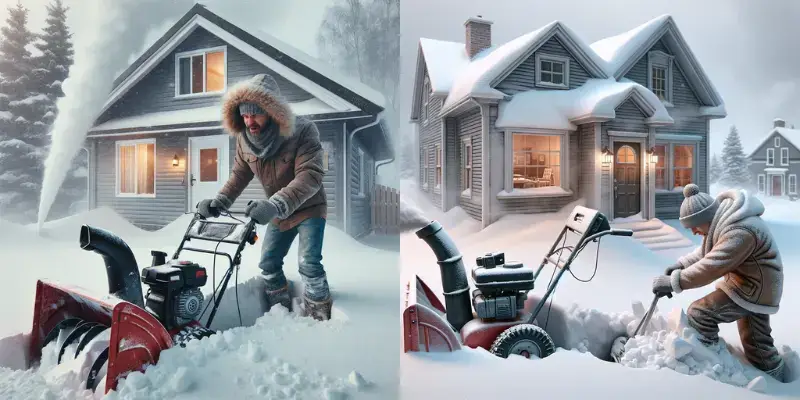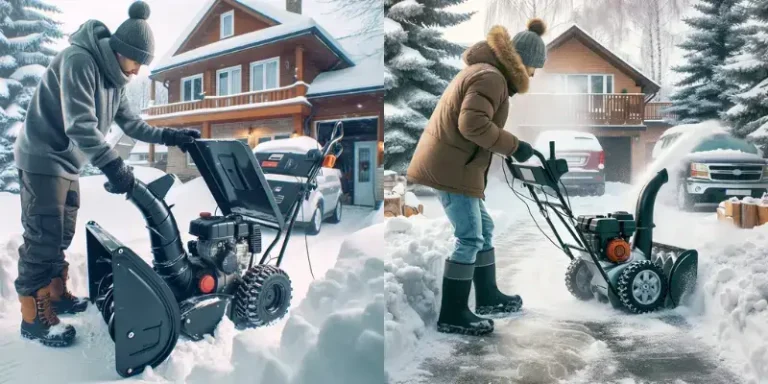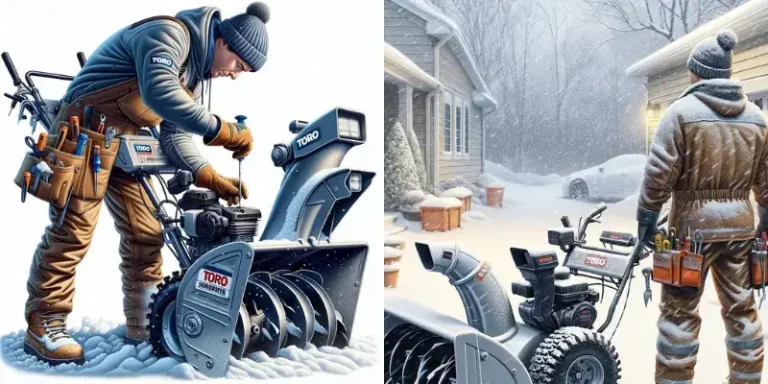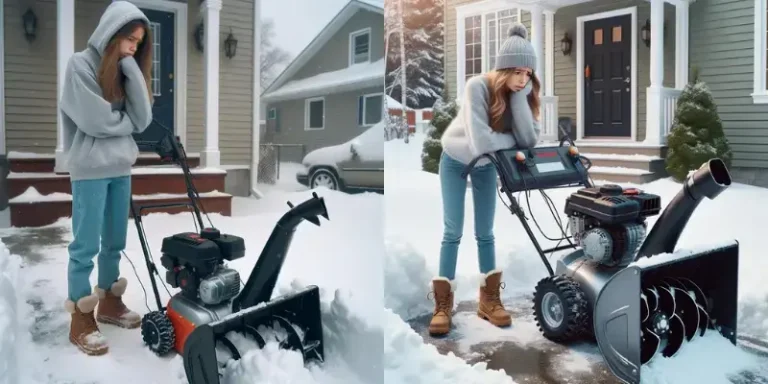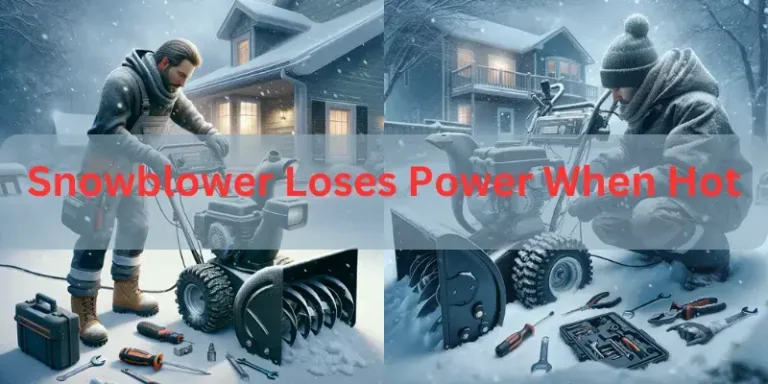How to Snowblow Safely and Effectively in 2024: A Comprehensive Guide
Picture this: a winter wonderland in your backyard, all fluffy and white. Beautiful, right? But then comes the task of clearing it up. A question that tickles your mind continuously that How to Snowblow Safely and Effectively?
“Snowblowing, while efficient, is no child’s play. In this guide, I will share the essentials of snow-blowing safety, keeping you warm, secure, and effective in tackling those snowy drifts. From understanding the importance of safety, and preparing for the task, to maintaining your snowblower for years to come”
Why Snowblowing Safety Matters
When the snow starts to accumulate, reaching for the snowblower often seems like the quickest solution to clear your paths and driveways. However, it’s important to pause and consider the importance of safety in this seemingly routine task.
The Benefits of Snowblowing for Your Home and Health
Safety and Accessibility at Home
Snowblowing goes beyond just aesthetics; it’s a key factor in home safety. By removing snow, you reduce the risk of slips and falls, ensuring safe access for everyone from family members to emergency responders. It’s not just about a clear driveway, but about maintaining a safe, accessible environment around your home.
Snowblowing as Exercise
Engaging in snow blowing is also a great way to stay active during the winter. This task requires physical effort, which helps in exercising various muscle groups. It’s an effective, practical way to maintain physical activity, especially when cold weather might deter you from other forms of exercise. With this activity, you’re not only clearing snow but also getting a good workout.
The Risks and Hazards of Snowblowing
Potential for Flying Debris
Using a snowblower can inadvertently kick up flying debris such as stones or solid ice. These projectiles can pose a risk not just to the operator but also to bystanders or property. Protective gear like goggles and sturdy clothing can help mitigate these risks, ensuring a safer snow-blowing experience.
Machine-Related Mishaps
Snowblowers, being powerful machines, also come with their own set of hazards. This includes the risk of jams and malfunctions, which can be dangerous if they result in unexpected contact with moving parts.
To prevent these mishaps, regular maintenance of your snowblower is essential, along with a thorough understanding of its operation. Always approach with caution and respect for the machine’s capabilities, prioritizing safety in every aspect of its use.
The Statistics and Facts about Snowblowing Injuries and Accidents
The risks associated with snowblowing are not merely hypothetical. Each year, thousands are injured while snowblowing, ranging from minor cuts and bruises to more severe, sometimes life-altering injuries. These statistics aren’t just numbers; they’re a sobering reminder of the importance of safety practices.
They underscore the need for proper preparation, awareness, and adherence to safety guidelines while operating a snowblower. By being aware of these facts,
How to Prepare for Snowblowing
Before you fire up your snowblower and tackle the winter blanket covering your driveway, a little preparation can go a long way in ensuring not just effectiveness, but also your safety.
Getting ready to remove snow isn’t just about starting the engine; it involves taking steps to protect yourself, ensuring your environment is safe, and verifying that your equipment is in top condition.
Dressing Appropriately for the Weather
Bundling up is key! When it comes to snow blowing, what you wear can make a big difference in your comfort and safety. The goal is to stay warm and dry, so layering is essential. Start with a moisture-wicking base layer to keep sweat at bay, add an insulating layer for warmth, and top it off with a waterproof outer layer to protect against snow and wind.
Don’t forget your extremities – thermal gloves, a warm hat, and waterproof boots are crucial in guarding against frostbite and hypothermia. Also, consider wearing eye protection to shield your eyes from flying snow and debris.
Checking the Area for Obstacles or Debris
Before you start snow blowing, take a moment to walk around the area you plan to clear. A quick scan can prevent major mishaps. Hidden objects like rocks, toys, or branches buried under the snow can become dangerous projectiles when caught in the snowblower’s blades.
Clearing these obstacles beforehand not only protects you and your snowblower but also ensures a smoother, more efficient snow removal process.
Inspecting Your Snowblower
A well-maintained machine is a safe one. Regular checks and maintenance of your snowblower can prevent unexpected malfunctions during use. Before each use, inspect your snowblower for any signs of wear or damage.
Check the auger and impeller for any blockages or debris, ensure all bolts and belts are tight and in good condition, and verify that the controls are working properly. It’s also important to check the oil and fuel levels.
By taking a few minutes to inspect your snowblower, you can prevent breakdowns mid-job and extend the life of your machine.
How to Snowblow Efficiently and Effectively
Stepping into the cold to snowblow your driveway can be daunting, but with the right approach, it can be both efficient and safe. Removing snow and using a Snowblower isn’t just about pushing the machine forward; it’s about understanding its capabilities and being mindful of your environment.
Proper Operating Procedures and Adjusting Settings
Each snow situation is unique – from a light, fluffy dusting to a heavy, wet blanket. Your snowblower is a versatile tool, but only if you know how to use it right. Start by familiarizing yourself with its settings. Adjust the height of the snowblower to match the snow’s depth.
For lighter snow, a higher setting works well, while deeper snow requires a lower setting to effectively clear the area. Pay attention to the chute direction too; adjusting it as needed ensures that you’re not just moving the snow from one place to another, but clearing the area.
Also, consider the speed; go slower for heavy, wet snow and faster for lighter accumulations. By adjusting your snowblower’s settings according to the conditions, you can maximize efficiency and reduce the strain on both you and the machine.
Being Aware of Surroundings and Avoiding Hazards
Effective snow blowing is as much about operating the machine as it is about being conscious of your environment. Snow can mask otherwise visible hazards, so it’s important to stay alert.
Be on the lookout for ice patches, which can cause slips and falls or make controlling the snowblower difficult. Also, watch for uneven terrain, like hidden steps or curbs, which can pose a risk of tripping or damaging your snowblower.
Furthermore, it’s important to avoid snow blowing in extreme weather conditions, such as during a blizzard or in extreme cold, as these conditions can be dangerous and make the task much more difficult. By being aware of your surroundings and avoiding hazards, you can ensure a safe and effective experience.
Avoiding and Safely Clearing Clogs and Jams
Encountering clogs and jams in your snowblower is a common issue, especially in heavy or wet snow conditions. However, handling these situations safely is crucial to prevent injuries and damage to your machine. Here’s how to deal with clogs and jams effectively:
Prevention is Key:
The first step is to try and prevent clogs before they happen. This can be done by snow blowing at a steady, consistent pace. Forcing the machine into heavy snow at high speeds increases the likelihood of clogs. If you notice the snow is particularly wet and heavy, take smaller passes to reduce the burden on your snowblower.
Turn Off the Snowblower:
If you do encounter a clog, the first and most important step is to turn off the snowblower. Never attempt to clear a clog while the machine is running. Even if it seems stuck, the auger or impeller might still have tension and could start moving unexpectedly.
Use a Clearing Tool:
Most snowblowers come with a clearing tool specifically designed for removing clogs. It’s a safer alternative to using your hands or other objects. If your model didn’t come with one, a broom handle or similar object can work. Just ensure it’s sturdy enough to handle the task without breaking.
Clearing the Clog:
After ensuring the machine is completely powered off, use the clearing tool to gently remove the snow and debris from the chute and auger area. Be thorough but gentle to avoid damaging any parts of the snowblower.
Double-Check Before Restarting:
Once you’ve cleared the clog, give your snowblower a quick once-over to ensure there are no remaining blockages. Check the auger and impeller again to make sure they move freely.
Start the Machine Safely:
Once everything is clear, start your snowblower according to the manufacturer’s instructions. Be prepared for the possibility of the machine throwing some residual snow or debris from the cleared clog.
By following these steps, you can safely and effectively deal with clogs and jams, ensuring your snowblowing task remains as safe and efficient as possible. Remember, your safety is paramount, so never rush or skip steps, especially when dealing with potential clogs.
How to Maintain Your Snowblower and Extend Its Lifespan
Maintaining your snowblower is not just a chore, it’s an investment in its lifespan and performance. A well-maintained snowblower not only runs more efficiently but also poses fewer safety risks.
Turning Off and Disconnecting the Power
Safety first! Whether you’re performing a quick clean-up or a thorough maintenance check, always start by turning off your snowblower. If it’s electric, unplug it; if it’s gas-powered, turn off the engine.
This precaution is vital to avoid any accidental startups while you’re working on the machine. Remember, taking a few seconds to ensure the power is off can prevent potential accidents and injuries.
Cleaning and Removing Snow or Ice Buildup
After each use, take some time to clean your snowblower. Snow and ice left on the machine can melt and refreeze, potentially causing damage and reducing its efficiency. Use a brush or cloth to gently remove snow and ice from all parts of the snowblower, especially around the auger and chute. Pay attention to any nooks where snow might accumulate.
Regular cleaning not only prevents rust but also gives you the chance to spot any damage or wear that might need attention.
Storing Your Snowblower Properly
When the snow season ends, proper storage of your snowblower is essential for prolonging its life. Before storing, make sure it’s clean and dry. If your snowblower is gas-powered, stabilize or drain the fuel to prevent degradation.
Store your snowblower in a dry, covered area to protect it from moisture and rust.
Covering it with a tarp or special snowblower cover can also help protect it from dust and debris. Lastly, consult your owner’s manual for any specific storage recommendations for your model.
By following these maintenance tips, you ensure that your snowblower remains reliable, efficient, and ready to tackle the winter season year after year. Regular maintenance not only saves you time and money in the long run but also keeps you safe while operating the machine.
Conclusion
Snowblowing, when done safely and efficiently, can make your winter experience much more enjoyable. Remember to dress appropriately, inspect your equipment, operate with care, and maintain your snowblower for long-lasting use. Take these tips to heart, and you’ll not only clear your driveway but also pave the way for a safe, fun, and productive winter season. So, gear up, stay safe, and use the snow blower hassle-free.

About Naveed A Hashmi
In my childhood, I used to see my parents while working in the land, for these reasons today I have been serving the same as our own tradition and culture. I thus love to stay in it, because I want to learn something advanced and new so that I may improve my farm’s contour and help others with my experience.

